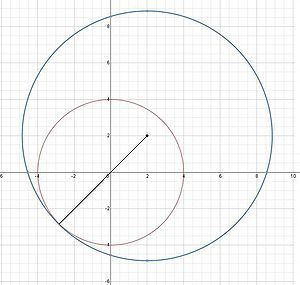Science:Math Exam Resources/Courses/MATH105/April 2013/Question 05 (a)
{{#incat:MER QGQ flag|{{#incat:MER QGH flag|{{#incat:MER QGS flag|}}}}}}
• Q1 (a) • Q1 (b) • Q1 (c) • Q1 (d) • Q1 (e) • Q1 (f) • Q1 (g) • Q1 (h) • Q1 (i) • Q1 (j) • Q1 (k) • Q1 (l) • Q1 (m) • Q1 (n) • Q2 (a) • Q2 (b) • Q2 (c) • Q3 (a) • Q3 (b) • Q4 (a) • Q4 (b) • Q5 (a) • Q5 (b) • Q6 (a) • Q6 (b) •
Question 05 (a) |
|---|
|
A study conducted at a waste disposal site reveals soil contamination over a region that can be described as the interior of the circle where x and y are in miles. In order to build a circular enclosure to contain all polluted territory, the manager of the site wants to find the radius of the smallest circle centered at (2, 2) that contains the entire contamination region. Formulate this as a constrained optimization problem, clearly stating the objective function and the constraint. Note that you do not need to do any computation in part (a). |
|
Make sure you understand the problem fully: What is the question asking you to do? Are there specific conditions or constraints that you should take note of? How will you know if your answer is correct from your work only? Can you rephrase the question in your own words in a way that makes sense to you? |
|
If you are stuck, check the hints below. Read the first one and consider it for a while. Does it give you a new idea on how to approach the problem? If so, try it! If after a while you are still stuck, go for the next hint. |
Hint 1 |
|---|
|
We with to make the radius of the new circle around (2,2) as small as possible and as large as necessary to contain all points from the first circle around (0,0). |
Hint 2 |
|---|
|
Given any point (x,y), what is the distance from that point to the centre of our new cirle (2,2)? |
|
Checking a solution serves two purposes: helping you if, after having used all the hints, you still are stuck on the problem; or if you have solved the problem and would like to check your work.
|
Solution |
|---|
|
Examine the picture below The red circle describes the contaminated region. Our blue circle has to be just large enough to completely contain the red circle. Hence, we need to find the distance between any point on the red circle and the centre of the blue circle, (2,2). The radius of the blue circle is then the smallest number that is bigger than all these distances. The distance between any point (x,y) and (2,2) is given by . Hence, the radius r we are looking for is the maximum value of distances from points on the red circle to the centre of the blue circle:
subject to this point lying on the red circle
Maximizing this distance gives the smallest possible radius such that the blue circle still encloses the entire contamination area. |
{{#incat:MER CT flag||
}}





